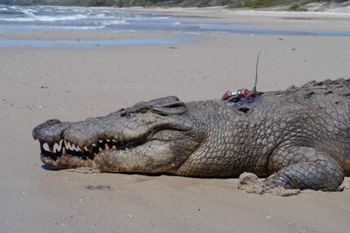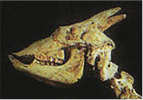Despite being poor swimmers, researchers have discovered that the saltwater crocodile (also known as estuarine) commonly travels long distances over open oceans by riding ocean currents. The discovery, published in Journal of Animal Ecology, solves an unknown mystery of why saltwater crocodiles (Crocodylus porosus) are found across vast distance in the Pacific, yet have not diverged into different species.
Researchers tracked 27 adult saltwater crocodiles for one year using tags and sonar transmitters. The tagging showed that crocodile individuals, both male and female, regularly traveled more than 50 kilometers from their local rivers into the open sea. One crocodile traveled 590 kilometers in 25 days; another traveled 411 kilometers in 20 days.
 A 4.8 m male estuarine crocodile ready for release with satellite transmitter. This crocodile traveled over 590 km by sea. Photo courtesy of: the Australia Zoo. |
The study found that the crocodiles begin their long-distance travel within an hour of the tide changing, allowing them to ride the current. When the tide turned the crocodiles would haul themselves up on to a river bank to wait for a favorable tide, sometimes they even waited days for the right tide.
“[The crocodiles] can survive for long periods in salt-water without eating or drinking, so by only travelling when surface currents are favorable, they would be able to move long distances by sea. This not only helps to explains how estuarine crocodiles move between oceanic islands, but also contributes to the theory that crocodilians have crossed major marine barriers during their evolutionary past,” lead author Dr Hamish Campbell from University of Queensland said.
The saltwater crocodile’s range extends from India to Fiji and from southern China to northern Australia. They are the world’s largest crocodile species.
Related articles
Savior of endangered crocodiles dies of malaria
(02/25/2010) Crocodile-expert and conservationist, Dr. John Thorbjarnarson, died of falciparum malaria in India on February 14th at the age of fifty-two. While many conservationists work with publicly popular animals like tigers and whales, Thorbjarnarson’s passion was for crocodiles. A Senior Conservation Scientist with the Wildlife Conservation Society (WCS), Thorbjarnarson proved instrumental in saving both the Orinoco crocodile and the Chinese crocodile from extinction.
Extinct goat was “similar to crocodiles”

(11/16/2009) It sounds like something out of Greek mythology: a half-goat, half-reptilian creature. But researchers have discovered that an extinct species of goat, the Balearic Island cave goat or Myotragus balearicus, survived in nutrient-poor Mediterranean islands by evolving reptilian-specific characteristics. The goat, much like crocodiles, was able to grow at flexible rates, stopping growth entirely when food was scant. This adaptation—never before seen in a mammal—allowed the species to survive for five million years before being driven to extinction only 3,000 years ago, likely by human hunters.
DNA uncovers nearly extinct Siamese crocodiles in captivity
(11/15/2009) The Critically Endangered Siamese crocodile, once believed to be extinct in the wild, received some uplifting news this week. DNA testing of 69 rescued crocodiles at Phnom Tama Wildlife Rescue Center (PTWRC) in Cambodia found 35 purebred Siamese crocodiles.